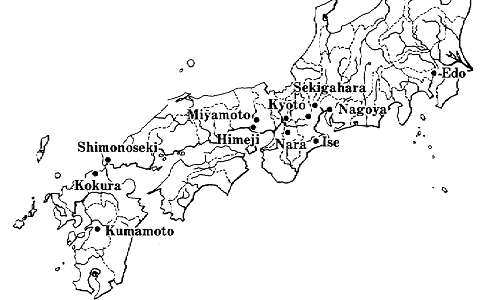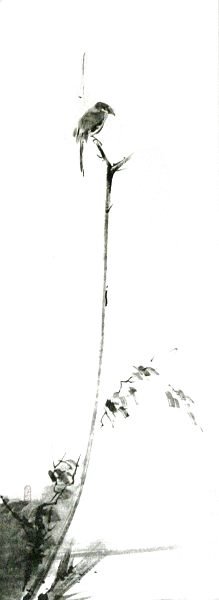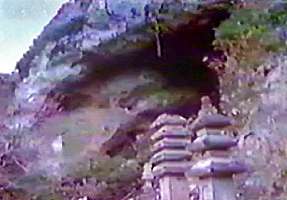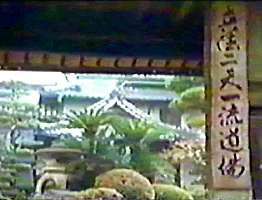Hyoho Niten Ichi Ryu

KAMAYURU TO OMOWAZU KIRU
KOTO NARI TO OMO UBESHI
- Miyamoto Musashi -
Hyoho Niten Ichi Ryu lineage
This is the lineage of Hyoho Niten Ichi ryu, from the founder to the present headmaster (there is some controversy after Aoki):
Miyamoto Musashi Fujiwara no Genshin
|
Terao Kyumanosuke Nobuyuki
|
Terao Kyoemon Katsuyuki
|
Yoshida Josetsu Masahiro
|
Santo Hikozaemon Kiyoaki
|
Santo Hanbei Kiyoaki
|
Santo Shinjuro Kiyotake
|
Aoki Kikuo Hisakatsu
|
Kiyonaga Tadanao Masazane
|
Imai Masayuki Nobukatsu
Life of Miyamoto Musashi
Musashi's reputation as a swordsman was considerable even before his death, but few facts are known about him, not even the exact year and place he was born. Most of his actions depicted in later narratives are based on legend and fiction.

principal places in Musashi's life
Miyamoto Musashi as an artist
During his lifetime Musashi was as famous for his artwork as for his fighting skill. He created remarkable paintings, as well as work in clay, wood and metal, calligraphy, poems and songs. Some of his works have been declared National Treasures.
The 35 articles on the art of Swordsmanship
Some time after entering the service of Hosokawa Tadatoshi in Kumamoto, Musashi wrote the "35 articles on the art of swordsmanship" (hyoho sanjugo kajo) at his lord's request. This book is considered the prototype for Musashi's final work, the book of five elements. Although written in a seemingly unsophisticated style, it is difficult to understand without knowledge of swordsmanship. Paradoxically it is the seeming simplicity which conveys the tremendous skill of Musashi.
One article subtitled "naming my fencing style the two-sword style" reads as follows:
Because I hold two swords, I call my fencing style two-sword swordsmanship. Holding a sword in my left hand [as well as my right] implies nothing special. It only helps me gain the skill to be able to hold a sword with a single hand [instead of gripping one sword with two hands as was customary]. If a man were galloping along a narrow path near a river or if he were in a battle crowded with samurai, he would hold his shield in his left hand, thus restricting the free use of that hand. He would then have no choice but to grip his sword only with his right hand. [Without training] he will feel that sword inordinately heavy. Only when a man has experience and is accustomed to wielding a sword with one hand [can he excel in battle.] When an archer becomes experienced by shooting arrows in training, his shooting ability soars. When a man becomes accustomed to riding horses, he can command a horse well. This is not only true of martial arts but can also be applied to the everyday. For example, with practice fishermen can excel in rowing and farmers in plowing. In the same way, men, with experience, can attain superior ability with a sword [wielding it in one hand]. Needless to say, a swordsman must choose a sword that corresponds to his physical strength.
A second article teaches us how to hold a sword:
A sword is to be held in the following manner: the middle, fourth and little fingers should grip the hilt vigorously while the thumb and index finger should be lightly placed on the hilt. There are two types of swords and hands - live ones and dead ones. If the hands grips the sword too firmly when taking the stance or parrying, then it is too difficult to take the offensive. These are what I call "dead" hands. On the other hand, if one grips the sword in a relaxed manner, he can continually take the offensive. These are "live" hands. One must not cross one's wrists nor bend one's elbows too much or too little. Muscles on the upper side of the arm should be relaxed, those on the lower taut.
A third article explains how a fencer should face his opponent:
Since olden days many opinions have been expressed about which part of an opponent one should look at [during a duel] but the majority of people have supported staring at an opponent's face. When so doing, the eyes should be narrower than usual but the mind should be broad. The eyeballs should not move and when the opponent is near they should be focused as though they were looking into the distance. In this way, a man can look at not only his opponent's face but his whole body, thus being able to anticipate any offensive thrusts he might make. In my opinion, there are two kinds of eyes: one kind simply looks at things and the other sees through things to perceive their inner nature. The former should not be tense [so as to observe as much as possible]; The latter should be strong [so as to discern the workings of the opponent's mind clearly]. Sometimes a man can read another's mind with his eyes. In fencing, it is all right to allow your own eyes to express your will but never let them reveal your mind. This matter should be considered carefully and studied diligently.
Musashi went on to explain every aspect of fencing: how to take steps, how much time to leave between strokes, ho w much space should separate fencers, how to wield two swords, how to inculcate the proper mental attitude. In short, this book represented all that Musashi had learned through his experience and his training. Each article, indeed, each sentence is packed with jewels of wisdom.
The Book of Five Elements
Gorin no sho, "book of five elements," is a treatise on hyoho. The term hyoho (or heiho), an all-encompassing term for the art of fighting, may express notions ranging from military strategy to individual combat. The word gorin in the title refers to the five elements of the phenomenal world in Buddhist belief; earth, water, fire, wind, and emptiness. The naming of the volumes after the elements is judged to be largely for convenience, philosophical connections to the subject matter are tenuous at best.
Musashi's words in the preface reflect a confidence born of true mastery in the art of swordsmanship:
I have had no masters, no fencing teachers. I would like to describe the true core of swordsmanship which I have fathomed through my two-sword fencing style in this book, not by quoting Buddhism or Confucianism, not by alluding to historical events or wars, but only by appealing to the goddess of Mercy and to the Goddess of the Sun....
Behind Ungan-ji temple on the slope of mount Kimpu west of Kumamoto stands a rock cave in which a stone image of a four-faced Kwannon (goddess of mercy) is enshrined. The sixty year old Musashi went to this cave to draft his last work. His dying words were a book on the essence of swordsmanship and tactics.
An article on the gorinnosho by current headmaster Imai Masayuki soke can be found here.
The Dokkodo
Musashi compiled a list of precepts, that is known as the Dokkodou (the path of self-reliance). The following translation appeared in a Japanese Sword Society/US newsletter. The translation was made in 1965 by Professor Giichiro Ikeda.
The Way I Go By Myself
- I never act contrary to traditional morality.
- I have no partiality for anyone or anything.
- I never try to snatch a moment of ease.
- I think little of myself but much of the public.
- I am entirely free of acquisitiveness throughout my life.
- I never regret what I have done.
- I never envy others for their good luck, or on account of my ill luck.
- I never grieve at parting from anyone or anything at whatever time.
- I never reproach either myself or others; never complain about myself or others.
- I never dream of falling in love with a woman.
- Likes and dislikes, I have none.
- Whatever my dwelling house may be, I take no objection to it.
- I never desire dainty food for myself.
- I never have antique objects or curios in my posession.
- I never perform purification or observe abstinence to protect myself against evils.
- I have no taste for implements of any kind, excepting swords and other arms.
- I would never grudge my life in the cause of righteousness.
- I never wish to have any estate that would make my old age comfortable.
- I worship Gods and Buddhas, but never think of depending on them.
- I would sooner lay down my life than disgrace my good name.
- Never for a moment does my heart and soul stray from the way of swordsmanship.
The 12th day of the 5th month, the 2nd year of Shoho (May 12, 1645) Shinmen Musashi
The Techniques of Hyoho Niten Ichi Ryu
![]()
Hyoho Niten Ichi Ryu was founded in the first half of the 17th century by Miyamoto Musashi Fujiwara Genshin (1584-1645). Present headmaster is 10th soke Imai Masayuki. Niten Ichi ryu techniques are economical, without flashy or exaggerated movements. Targetting is precise, and the distance and timing is tight and without wasted movement. The bokuto used in Niten Ichi Ryu are thin and light, to allow proper one-handed control, and to prevent excessive tiring during extended practice holding the bokuto at shoulder level. (says Diane in Koryu Bujutsu)
Literature on Musashi
Lives of master swordsmen. Makoto Sugawara, the East Publications,
1988.
Out of print.
A
book of five rings, Miyamoto Musashi, Victor Harris, 1974.
Don't read Harris' introduction, it's full of historical errors.
Read "lives of master swordsmen" instead for a biography of Musashi.
The
book of five rings, Miyamoto Musashi, Thomas Cleary, Shambhala, 1994.
Slightly different translation, and at least doesn't include
any bizarre "history".
Legends
of the samurai, Hiroaki Sato, Overlook press, 1995.
It contains a partial translation of Musashi's book of five
rings.
Musashi.
Eiji Yoshikawa. Kodansha International, 1995.
A fascinating epic based on the life of the most famous
swordsman of Japan.




